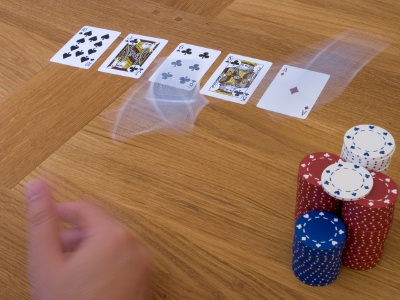|
|

Scare Card - A card which is dangerous enough to scare the player who has been betting, because it completes one or more
powerful draws.
The term “scare card” is typically used to describe a dangerous turn or river card in a flop game. It is called a scare card because
it can do just that, scare the player who has been betting. The turn or river card frequently changes the complexion of the board and
can make the player who has been betting question whether his hand is still good, because the newly dealt card appears to complete a
powerful drawing hand. Sometimes, if the scare card is dangerous enough, it will cause the player who has been betting to check instead.
Any card that completes a nut straight, a flush, or full house can be considered a scare card. Since your opponent will frequently
hold an ace, an ace can also be considered a scare card when it hits. When a turn or river card brings a three flush or a four flush,
or if the board pairs or double pairs, it is often considered a scare card. Depending upon the quality of the potential straight, and
the texture of the board, a card that potentially completes a straight may or may not be dangerous, and therefore may or may not be
considered a scare card.
When you have five community cards on
board, a straight is often possible, but not every straight is likely to be present. Many of these straights are completed only by
non-connecting, low ranking cards which your opponent is unlikely to be holding. For example if the flop came 9-5-2, any A, 3, 4, 6,
7, or 8 makes the straight possible. But, for the most part, these are unlikely combinations for your opponents to be holding.
Therefore, the cards that fill in this straight are typically not considered scare cards. Alternatively, If the Flop comes J-T-8, Any
A, K, Q, or 9, would likely be considered a scare card, because the hands that complete a straight in this situation are frequently played.
So the danger level associated with a scare card is defined by the other related cards on the board. A scare card becomes extremely
dangerous if you opponent need only use one of his hole cards to complete his hand, rather than both. This occurs most frequently when
there is a four card straight or flush on the board, or if the board is double paired. Sometimes, in a really dangerous scare card
situation, a single card can appear likely to complete multiple draws.
When a scare card hits, the player who is betting must decide if the card is dangerous enough to make them stop betting and check
their hand. This is often a critical decision, for several reasons. First of all, you do not want to check and give your opponents a
free card, if your hand is still good. Free cards kill, because they often hit a player who was unable to call if there has been a
bet, but since there was no bet, they were able to back into a hand.
While it can be fatal to give a free card, betting into a scare card can also have devastating results. Since the scare card arrived
on the turn or the river, you will frequently be betting more than you did on the flop. If you now have the worst hand and are betting
into a player who has just sucked out on you, you will be on the hook for both your large bet as well as a raise from your opponent.
You may also get locked into calling additional bets before the hand is over.
Sometimes, the correct way to proceed is to bet into the scare card and to throw your hand away if your opponent raises you. This
strategy prevents your opponent from receiving any free cards, and it also keeps you from having to pay your opponent off during the
remainder of the hand. The problem with this strategy is that it if your opponent recognizes it, it then becomes fairly easy for him
to counter. All he has to do to take the pot from you is to raise you on the turn or the river, and you will
muck. This is one reason that you should avoid
playing in a strict pattern. If you mix up your play effectively, your opponent will have a hard time putting you on a hand, and this
will prevent him from playing at you too frequently.
Usage: No Free Cards, Free Card Play, Checked For A Free Card
Previous Poker Term: Satellite
Next Poker Term: Scoop
|
|









